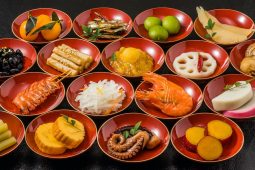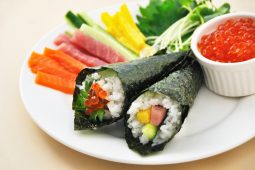Imagine Kyoto and you are likely to think first of its many shrines, temples, and tranquil gardens. However, Kyoto is almost as famous for its food as for its historical sites. The unique cuisine that developed in Kyoto over the centuries is called Kyō-ryōri and is famous for its sophisticated presentation, delicate flavors, and extremely healthy ingredients. In this article we will introduce some of the main elements and types of Kyō-ryōri – and tell you where to eat them!

Tofu plays a key role in Kyō-ryōri, partly due to the influence of Buddhist vegetarian cuisine, and also because historically Kyoto’s inland location made fresh fish difficult to obtain. Tofu and other tofu-related products were a useful alternative to fish as a source of protein. Simmered tofu, called yudōfu in Japanese, is a traditional Kyoto specialty that is especially welcome in the cold winter months. The tofu is heated in a clay pot with a dashi (stock) made with kombu (kelp) and vegetables such as mizuna (Japanese mustard greens) and green scallions. Served with a dipping sauce it makes for a simple, tasty, and extremely healthy meal. There are many restaurants specializing in yudōfu meals around Nanzenji Temple. One of the more celebrated restaurants is Nanzenji Junsei where you can enjoy various meals which feature yudōfu as their main dish. This is a highly traditional restaurant with a beautiful stroll garden that you can view as you eat and explore after your meal.
Nanzenji Junsei website:http://www.to-fu.co.jp/en/
Google Map: https://goo.gl/maps/vGU2wDUSsKczkGBx5
Yuba is the skin that forms on the top of soy-milk as it is heated and is a by-product of the tofu-making process. It has a slightly sweet, creamy taste and a silky melt-in-the-mouth texture. Higashiyama Yuuzu is a restaurant specializing in yuba served in a variety of ways, such as in a hot pot, as yuba noodles, deep fried as a vegetable roll, or served as sashimi with a dipping sauce. They have set meals, full course menus and a la carte options too.
Higashiyama Yuuzu website: http://higashiyamayuuzu.main.jp/
Google Map: https://goo.gl/maps/oL9dRgBNzuZc6Ai77
Fu is a type of processed wheat gluten with a light chewy consistency which can be served with a variety of vegetable flavorings. As an alternative source of protein it is an important element of Buddhist vegetarian cuisine and also popular in the broader genre of Kyō-ryōri. Hanbey-fu is a 330-year-old fu store near Gojo Bridge, and behind their main shop they have a fu specialty restaurant called Sabo which is located in a traditional wooden machiya townhouse. Here you can enjoy a set meal with dishes such as grilled skewered fu with miso relish, stewed fu, fu sautéed in vinegar, fu soup, and crispy fried fu.
Hanbey-fu website: https://www.hanbey.co.jp/english/
Google Map: https://goo.gl/maps/hu1qRfJ7FHgEzJCx6
Hamo is a kind of pike conger that is eaten over the summer months in Kyoto. In the days before refrigeration and modern transportation, fresh fish was hard to get because everything had to be carried to Kyoto over the mountains from the sea. One fish that could be transported this way without spoiling was hamo. Hamo is a very strong fish, and so it could be kept alive and survive the long journey. Today hamo is still a popular item on the menus of Kyoto restaurants. Sakaiman is a 140-year-old restaurant that specializes in multi-course meals with hamo as the main ingredient. Served fried, battered, baked, stewed, in a light broth, with noodles, or as sashimi this delicately-flavored fish has great versatility. In Part 2 of this guide we will continue our introduction of Kyō-ryōri with a look at the main styles and more top restaurant recommendations.
Sakaiman website: https://www.facebook.com/kyoto.sakaiman
Google Map: https://goo.gl/maps/cHA7BubL41cJAUuf9
Sabazushi is salted mackerel sushi and another traditional Kyoto dish. In the past mackerel was salted to preserve it for the long journey to Kyoto. The route taken to bring the mackerel to Kyoto was actually called the Saba Kaidō, or “Mackerel Highway”. Unlike the delicate flavors of typical sushi which is dipped in soy sauce, sabazushi has a strong, rich flavor which needs no accompaniment. Izuu is a traditional Kyoto sushi shop first established in 1781, where you can enjoy their juicy, full-flavored sabazushi, and other varieties of salted sushi such as hamo (pike conger), anago (conger eel), tai (bream). These can be paired with local nihonshu (sake or rice wine) from the drinks menu, or a light refreshing white wine.
Izuu website: http://izuu.jp/
Google Map:https://goo.gl/maps/pid2NrzF4EE4mvZn9








